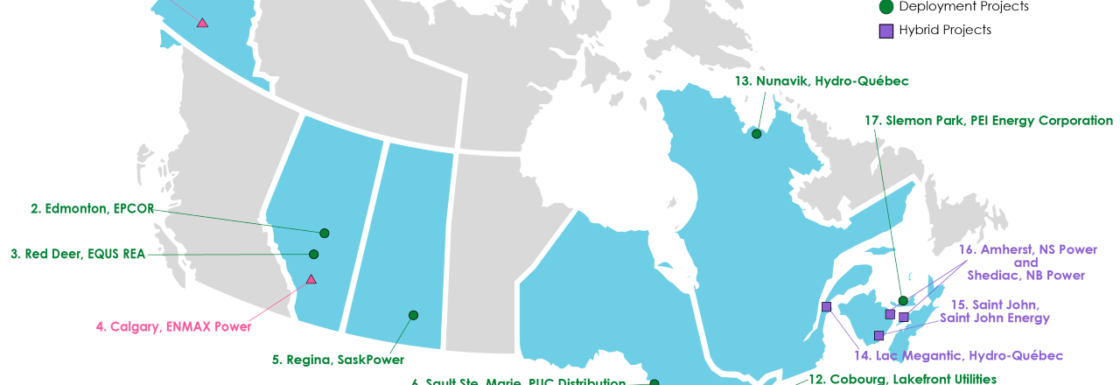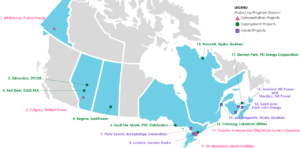Smart Grid Demonstration & Deployment Program: Natural Resources Canada

Projects Sponsor
NRCan’s Smart Grid Program was designed to deliver on environmental and economic commitments under the Pan-Canadian Framework on Clean Growth and Climate Change. The hundred million dollar program is funding projects to reduce GHG emissions by at least 0.9 MT by 2030, while preparing the grid for tomorrow. The program is notable not so much for what it’s trying to do, but how it’s trying to do it. It employs a systemic approach, engaging electricity utilities as key adopters.

The Pan-Canadian Framework for Clean Growth & Climate Change calls for programs to deliver on federal commitments and respond to provincial and territorial needs in the electricity sector (in addition to other energy sectors). Electricity represents the cleanest non-emitting form of energy in Canada, and it was clear to Natural Resources Canada (NRCan) that finding affordable ways to leverage these resources while further reducing energy emissions was key to lowering Canada’s carbon emissions.
While commercially available technologies capable of getting us much of the way to low-carbon electricity systems are emerging in Canada, when it comes to the role electricity can play in addressing emissions in other energy sectors, single technology fixes are not the answer.
What’s needed are systemic solutions and in a regulated sector––one that is undergoing significant sector transformations––with a large network of stakeholders, achieving those kinds of shifts is complicated.
What is the role of the federal government in this? That’s an important question and the Smart Grid Demonstration and Deployment Program is part of the answer, designed as it was set to accelerate the development of smart grids in order to reduce GHG emissions and generate economic growth and social benefits.
Following the 2017 budget announcement for the Smart Grid Program, stakeholder engagement efforts began in order to shape the criteria for project selection and performance evaluation. Over 350 power-system engineers, grid operators, policy-makers and leaders in industry associations and private sector partners participated in a series of online interactions to discuss how the program could better facilitate grid modernization and the development of new value-added services for customers while reducing emissions.
Smart Grid Program administrators also reached out to their counterparts in provinces with electricity infrastructure programs and the US DOE to learn from their experiences measuring performance and administering both deployment and demonstration programs aiming to accelerate innovation in the electricity sector.
All this input informed which performance measurements the program is trialing. The crafting of selection criteria and performance metrics against six program objectives for electricity systems was an important part of the project and they’re well worth listing out;
- GHG reductions
- Economic benefits and job creation
- Savings through operational efficiencies and asset deferral
- Increased reliability and resiliency
- Enable greater integration of renewable energy
- Maintain or improve cybersecurity
Proposals were reviewed by the Project Review Committee, an independent panel made up of 25 members representing federal departments, laboratories and academic experts from Canadian post-secondary institutions. The program selected 22 projects, most of which are now through the design phases and into construction phases or nearing completion.
In October 2019 the Program hosted its first Smart Grid Symposium. The Symposium promoted knowledge-sharing across the industry, showcased Smart Grid Program projects; and enriched NRCan’s capacity to better design and manage programs and contribute as a thought leader in the field.
Indeed it embodied the objectives and strategy of the program itself.
The symposium showcased Smart Grid Program projects to the 117 attendees, primarily from utilities, and curated conversations about how utilities replicate and scale innovative projects and incorporate visions for an energy transition in Canada into their corporate strategies and operational planning.
All this means NRCan is doing more than funding projects to reduce at least 0.9 MT in GHG emissions through cumulative project impacts by 2030. Much more.
Information-sharing across the industry is vital as is addressing both institutional barriers within government that prevent it from more effectively supporting and influencing change in industry and systemic industry barriers to grid modernization.
Unlocking the potential for greater GHG reduction in electricity and other energy sectors is key in the fight against climate change and as the NRCan’s Smart Grid Program demonstrates and facilitates, knowledge about power is power.














